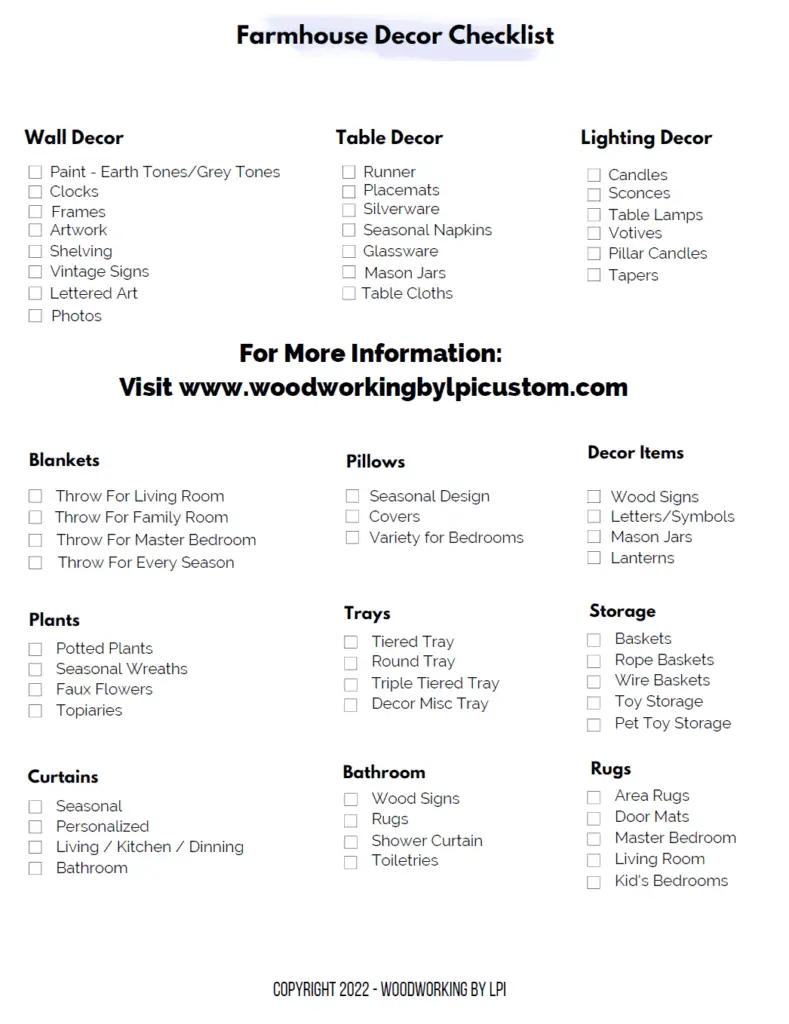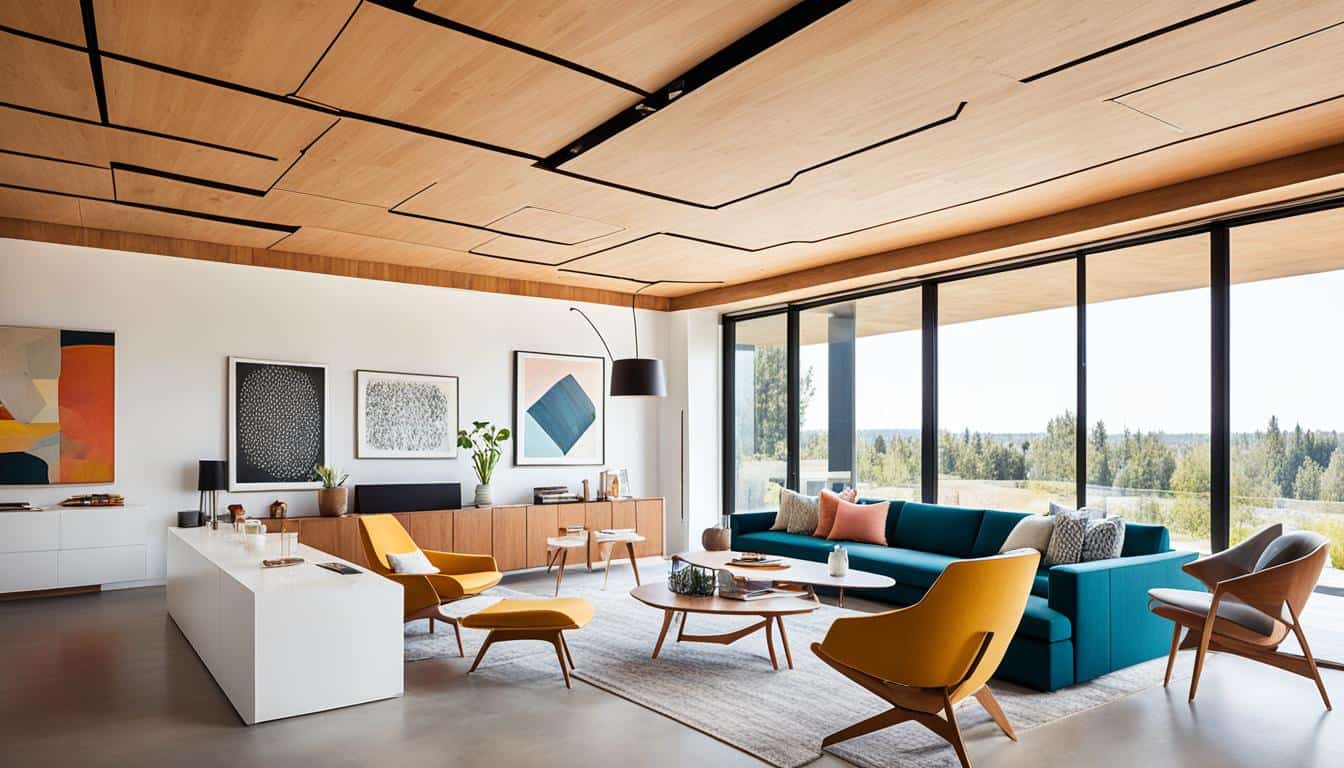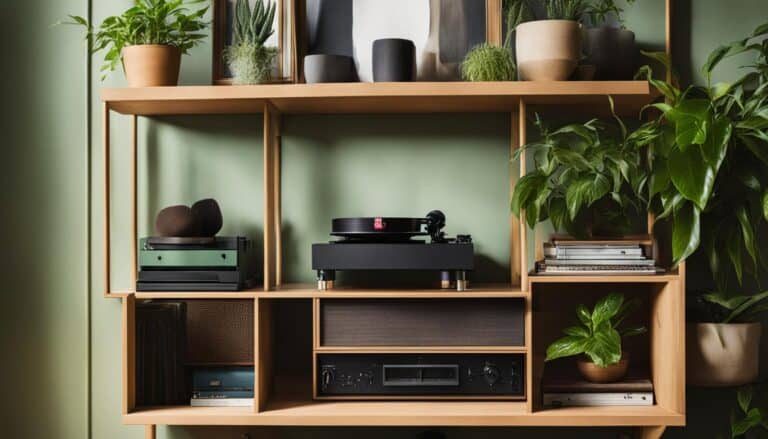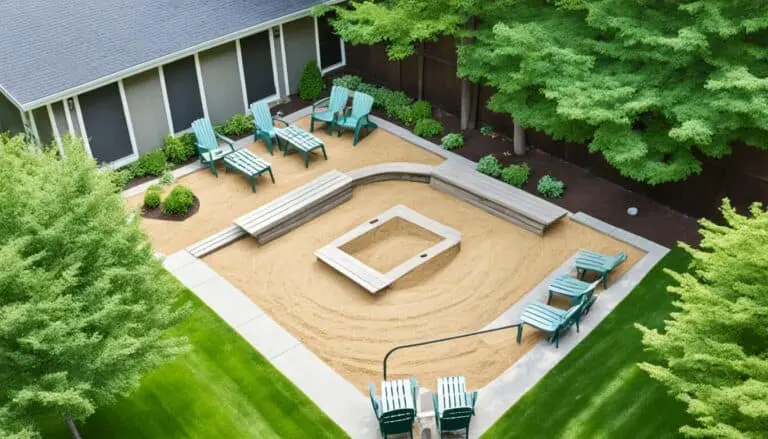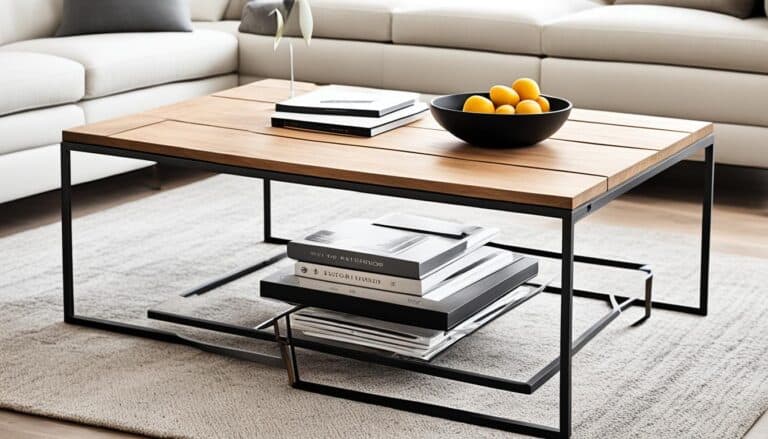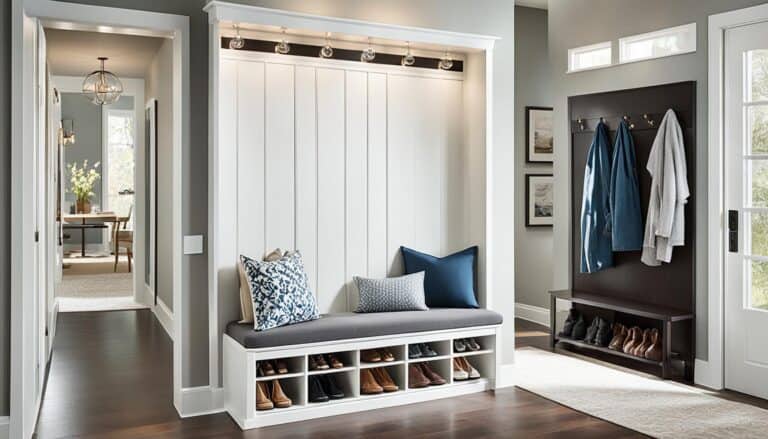Are you looking for a unique and cost-effective way to enhance the aesthetics of your home? Consider plywood ceilings. These versatile and stylish designs are gaining popularity in modern interiors, offering a wide range of options to suit your personal taste and style.
But how do plywood ceilings compare to traditional ceiling materials? Are they durable? And what design possibilities do they offer? Let’s explore the world of plywood ceilings and discover why they are becoming a go-to choice for homeowners.
Key Takeaways:
- Plywood ceilings are a popular choice for their aesthetic beauty and functional benefits.
- They are versatile, cost-effective, and easy to install and maintain.
- Plywood ceilings offer great soundproofing functionality and can be used to conceal wires and pipes.
- However, they are prone to termite and water damage and require expert cutting.
- With various designs available, including slanting, simple, all-white, and suspended ceilings, plywood offers endless possibilities for creating a stylish home interior.
Advantages of Plywood Ceiling Design
Plywood ceilings offer several advantages when it comes to designing your home. Here are some of the key benefits:
- Strength and Durability: Plywood is a strong and durable material, making it a practical choice for ceilings.
- Concealment of Wires, Pipes, and Ducts: Plywood can be used to hide unsightly wires, pipes, and ducts, resulting in a cleaner and more polished ceiling appearance.
- Cost-effectiveness: Plywood is a cost-effective alternative to other ceiling materials, providing value for money while maintaining quality.
- Soundproofing Functionality: Plywood has excellent soundproofing properties, which can help reduce noise transmission between floors and rooms.
- Environmental Friendliness: Plywood is an environmentally friendly choice as it is made from sustainable wood sources and can be recycled.
- Easy Installation, Handling, and Maintenance: Plywood ceilings are relatively easy to install, handle, and maintain, making them a convenient option for homeowners.
While plywood ceilings offer numerous advantages, it’s important to consider their limitations as well. Plywood ceilings can be more expensive compared to other materials like MDF, and they may require professional expertise for cutting and installation. Additionally, plywood ceilings can be vulnerable to termite and water damage, requiring proactive maintenance and timely repairs.
Maximizing the Benefits of Plywood Ceilings
To fully utilize the advantages of plywood ceilings, proper planning and design considerations are essential. Consult a professional to ensure accurate measurements and seamless installation. Additionally, regular inspections for termite or water damage can help preserve the integrity of your plywood ceiling over time.
Disadvantages of Plywood Ceiling Design
Despite the many advantages, plywood ceilings also come with a few challenges that you should consider before opting for this design option in your home. Understanding the disadvantages can help you make an informed decision.
Higher Cost Compared to MDF
One of the main drawbacks of plywood ceilings is their higher cost compared to materials like Medium Density Fiberboard (MDF). While plywood is known for its strength and durability, it does come at a higher price point. If you are on a tight budget, plywood ceilings might not be the most cost-effective option for you.
Expert Cutting and Installation Required
Plywood ceilings may require the expertise of professionals for proper cutting and installation. The precise cutting of plywood panels is essential to achieve a seamless and visually appealing result. Without proper cutting techniques, you may end up with uneven edges or misaligned panels, compromising the overall aesthetic of your ceiling.
Plywood Edges Require Finishing
Another challenge with plywood ceilings is that the edges of the panels need to be properly finished to avoid splintering. This includes applying veneer, sunmica, or laminate to achieve a smooth and polished look. Failing to finish the edges can result in rough surfaces that are not only visually unappealing but can also pose a safety risk.
Prone to Termite and Water Damage
Plywood ceilings are susceptible to termite and water damage, which can be challenging to repair. Termites can quickly infest the plywood, compromising its structural integrity. Additionally, exposure to moisture or leaks can cause warping, swelling, and mold growth, leading to the deterioration of the plywood panels. Regular maintenance and preventive measures are necessary to mitigate these risks.
Sculpting Plywood for Intricate Designs
Creating intricate designs with plywood can be a challenging task. Sculpting plywood requires careful planning, precise execution, and the skills of an experienced professional. Without proper techniques, intricate designs may not turn out as desired, affecting the overall aesthetic appeal of your ceiling.
“While plywood ceilings offer several advantages, they also come with a few disadvantages that should be considered. Higher cost, expert cutting and installation, the need for edge finishing, vulnerability to termite and water damage, and the challenges of sculpting intricate designs can impact the decision-making process.”
Slanting Plywood Ceiling Design
A slanting plywood ceiling design is a popular choice for creating an instant visual impact in your home. This design utilizes the versatility of plywood, allowing it to be easily cut into various shapes and sizes to suit your preferences. By incorporating a slanting design, you can add a unique touch to any space, making it stand out. This design works particularly well in bathrooms or areas with wooden furniture, as it creates an interesting contrast and adds a sense of depth to the room.
When it comes to slanting plywood ceiling designs, the possibilities are endless. You can opt for a single slanting panel across the ceiling or experiment with multiple slanting sections to create a dynamic visual effect. Additionally, you can incorporate lighting fixtures or skylights to enhance the overall ambiance of the room.
Plywood offers numerous benefits for ceiling designs, including its affordability, strength, and durability. It is a versatile material that can be easily manipulated to achieve the desired shape and angle. Moreover, plywood’s natural appeal complements various interior styles, from contemporary to rustic.
If you’re considering a slanting plywood ceiling design, it’s essential to consult with a professional to ensure precise measurements and accurate installation. This will help you achieve a seamless and visually striking result.
Benefits of Slanting Plywood Ceiling Design:
- Creates an instant visual impact
- Offers a unique touch to any space
- Works well in bathrooms or areas with wooden furniture
- Provides an interesting contrast
- Adds a sense of depth to the room
Simple Plywood Ceiling Design
If you are looking for a simple and natural-looking plywood ceiling design, consider using plywood to integrate natural elements into your home. A simple plywood ceiling design can enhance the overall aesthetic of the space, especially when combined with other natural elements like wooden flooring and exposed brick walls. This design creates a warm and inviting atmosphere in the room.
By incorporating plywood as the main material for your ceiling, you can achieve a minimalist and timeless look that complements various interior styles. The natural beauty of plywood adds warmth and texture to the room, creating a cozy and inviting ambiance.
If you prefer a clean and sleek look, opt for a plywood ceiling with a smooth, polished finish. This design choice allows the natural grain and patterns of the wood to shine through, adding depth and character to the space.
To enhance the natural appeal of your plywood ceiling, consider adding elements inspired by nature. For example, you can incorporate hanging plants or wooden beams to create a rustic yet modern look. These natural elements bring life and freshness to the room, making it feel like a serene oasis.
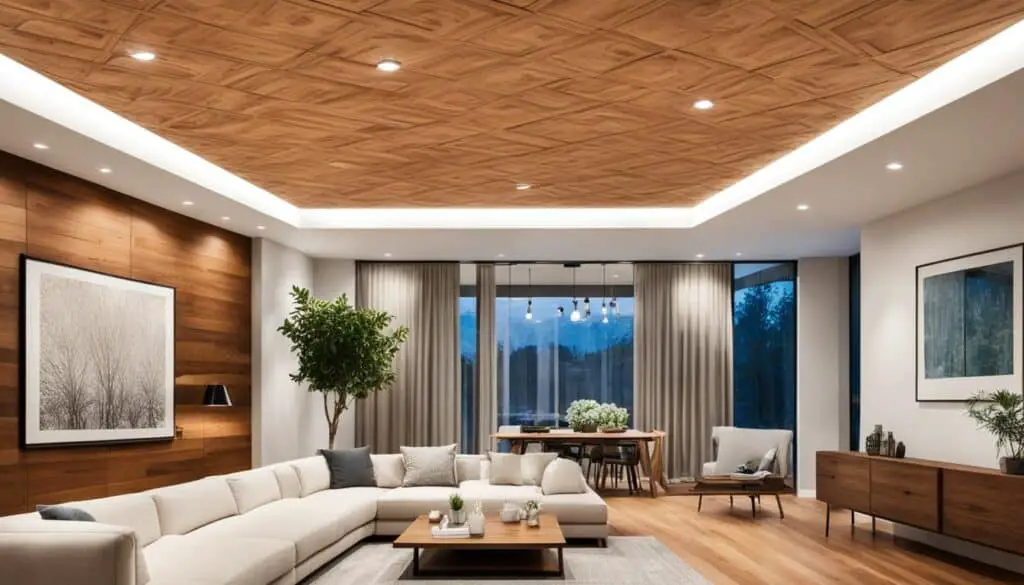
When selecting the color palette for your plywood ceiling, opt for neutral tones that harmonize with the natural elements. Earthy hues like beige, taupe, or shades of white work well to create a serene and calming atmosphere.
Remember to consider lighting when designing your plywood ceiling. The right lighting fixtures can highlight the beauty of the wood and create interesting shadows and patterns on the ceiling. Pendant lights or recessed lighting can be positioned strategically to enhance the plywood’s natural texture and grain.
Incorporating a simple plywood ceiling design with natural elements not only adds visual appeal to your space but also promotes a sense of well-being and harmony with nature. Whether it’s in your living room, kitchen, or bedroom, a plywood ceiling with natural elements is sure to create a cozy and inviting atmosphere.
Embrace the beauty of plywood and nature by opting for a simple plywood ceiling design that brings warmth, character, and serenity to your home.
All-White Plywood Ceiling Design
For a unique and modern plywood ceiling design for your bedroom, consider an all-white theme. While wooden furniture is often associated with brown wood, opting for a white plywood ceiling can create a fresh and stylish look. You can add plywood panels along the sides to give it a cottage-like feel. Adding statement decor elements like a stylish fan can elevate the look of the room.
| Benefits | Considerations |
|---|---|
| Creates a fresh and stylish look | Requires proper installation to avoid damage |
| Complements various design styles | May need additional decorative elements to enhance the aesthetic |
| Reflects light and brightens the room | Regular cleaning and maintenance required to keep it looking pristine |
“An all-white plywood ceiling design adds a touch of modern elegance and sophistication to any bedroom.”
White plywood ceilings have become increasingly popular due to their ability to create a clean and minimalist aesthetic. The color white adds brightness and lightens up the room, making it feel more spacious and airy. By opting for an all-white plywood ceiling, you can achieve a cohesive and harmonious look that complements a variety of design styles.
- Consider adding plywood panels along the sides of the ceiling to create a cottage-like ambiance.
- To enhance the overall look, incorporate statement decor elements such as a stylish fan or pendant light fixture.
- Regular cleaning and maintenance are essential to keep the white plywood ceiling looking pristine.
By choosing an all-white plywood ceiling design for your bedroom, you can create a serene and inviting space that exudes modernity and elegance. Whether your style is contemporary, Scandinavian, or farmhouse, an all-white plywood ceiling will add a touch of sophistication while maintaining a calm and tranquil atmosphere.
PoP and Plywood Combination
Combining plywood with plaster of Paris (PoP) can result in a breathtaking ceiling design that adds a touch of elegance to your home. By integrating these two materials, you can achieve a striking and unique aesthetic that complements various interior styles.
One captivating option is to incorporate exposed plywood logs, which bring a natural and rustic feel to your space. These exposed logs infuse warmth and character into the design, creating a cozy ambiance. Whether you’re aiming for a rustic or modern look, this combination offers versatility and visual appeal.
This design works exceptionally well in living rooms, where it can serve as a focal point and conversation starter. Pairing the PoP and plywood combination with white-painted walls creates a stunning Moroccan-inspired look, evoking a sense of timeless beauty and cultural charm.
To complete the overall aesthetic, consider adding elements of greenery and decorative lamps. The addition of plants not only enhances the natural feel but also brings life to the space, creating a soothing atmosphere. Decorative lamps provide soft lighting, accentuating the unique textures and patterns created by the PoP and plywood combination.
Combining plywood with plaster of Paris (PoP) can create a stunning ceiling design. Exposed plywood logs give a home a natural and rustic feel. This design works well in living rooms and can be paired with white-painted walls to create a Moroccan-inspired look. Adding greenery and decorative lamps completes the overall aesthetic.
| Pros | Cons |
|---|---|
| 1. Creates a stunning and unique ceiling design. | 1. Requires expert installation and handling. |
| 2. Adds a natural and rustic feel to your space. | 2. Susceptible to termite and water damage. |
| 3. Versatile and complements various interior styles. | 3. May be more expensive compared to other ceiling materials. |
| 4. Can serve as a focal point in living rooms. | 4. Requires regular maintenance and upkeep. |
| 5. Provides the opportunity to integrate greenery and decorative lamps. | 5. May require additional structural support. |
Wooden Cabin Style Plywood Ceiling
A wooden cabin-style plywood ceiling is an excellent choice to add warmth and coziness to your living room. This design not only enhances the aesthetic appeal of your space but also offers easy maintenance and installation. The rectangular grid-style ceiling creates a rustic cabin atmosphere, bringing a touch of nature indoors.
You can personalize your wooden cabin-style plywood ceiling by experimenting with various finishes for the exposed wooden logs. From natural wood tones to dark stains, the choice is yours to create a design that harmonizes with your overall decor scheme. The versatility of plywood allows you to achieve the cabin-like ambiance you desire.
| Advantages | Disadvantages |
|---|---|
|
|
“The wooden cabin-style plywood ceiling adds a touch of rustic charm to your living room, creating an inviting and comfortable space for relaxation and socializing.”
Embrace the natural beauty and warmth of wood with a wooden cabin-style plywood ceiling. Transform your living room into a cozy cabin retreat that you’ll love coming home to.
Latticework Plywood Ceiling Design
A latticework plywood ceiling design is a great option for creating a decorative and ornamental look in a hall or large room. This design adds a sense of old-world charm and elegance to the space. You can choose a grid-style design or opt for simplistic floral patterns to match your aesthetic preferences. The intricate craftsmanship of this design makes it visually appealing and gives your home a majestic look and feel.
Benefits of a Latticework Plywood Ceiling Design
- Adds an elegant and decorative touch to the space.
- Creates a sense of old-world charm and sophistication.
- Offers various design options including grid-style or floral patterns.
- Enhances the overall aesthetic appeal of the room.
- Provides a visually appealing focal point in the space.
How to Incorporate a Latticework Plywood Ceiling Design
To incorporate a latticework plywood ceiling design, follow these steps:
- Start by measuring the dimensions of the ceiling to determine the amount of plywood needed.
- Choose between a grid-style or floral pattern design for the latticework.
- Cut the plywood into strips or panels according to the desired design.
- Attach the plywood strips or panels to the ceiling using appropriate adhesives or fasteners.
- Paint or stain the plywood to match the desired color scheme.
- Add decorative elements such as lighting fixtures or chandeliers to enhance the overall look.
Example Image of a Latticework Plywood Ceiling Design
Suspended Plywood Ceiling Design
If you are willing to invest in a chic and stylish plywood ceiling design, consider a suspended plywood structure. This modern design creates an open and spacious feel in the room. You can hang bohemian-style lamps or add creepers to give your ceiling a natural and vibrant touch. This design can be customized with additional decor elements to suit your personal style.
With a suspended plywood ceiling, you can elevate the aesthetic appeal of any space. This design creates a unique focal point and adds a touch of sophistication to your home. The suspended structure provides a sense of airiness and creates the illusion of a higher ceiling, making the room appear larger and more spacious.
“The suspended plywood ceiling design offers a chic and contemporary solution for those who want to make a statement with their interior design.” – Jane Smith, Interior Designer
Combine the suspended plywood ceiling design with bohemian-style lamps or hanging plants to create a boho-chic ambiance. This combination adds a natural and vibrant touch to the space, creating a cozy and inviting atmosphere that is perfect for lounging or entertaining guests.
The suspended plywood ceiling design can be customized to suit your personal style and preferences. You can experiment with different finishes, such as staining the plywood for a rustic look or painting it with bold colors for a more vibrant and modern aesthetic. Additionally, you can incorporate other elements like decorative ropes or pendant lights to enhance the overall design.
Benefits of a Suspended Plywood Ceiling:
- Creates an open and spacious feel in the room
- Adds a touch of sophistication and elegance to your home
- Makes the room appear larger and more spacious
- Provides an opportunity to showcase bohemian-style lamps or hanging plants
- Can be customized to suit your personal style and preferences
Experience the beauty and versatility of a suspended plywood ceiling design. Elevate your home’s interior with this chic and modern alternative to traditional ceiling designs.
Plywood Design with Wooden Logs
For a straightforward plywood ceiling design, consider incorporating wooden logs. This design combines plywood with plaster of Paris (PoP) and wood to create a strong and robust look. Exposed brick walls and light-colored wooden floor tiles complement this design, creating a visually appealing and modern space.
Benefits of Plywood Design with Wooden Logs
Enhanced durability: The combination of plywood, PoP, and wooden logs creates a strong and sturdy ceiling design that can withstand daily wear and tear.
Visual appeal: The contrast between the plywood, PoP, and wooden logs adds a unique aesthetic to your space, making it visually striking and modern.
Natural warmth: The use of natural materials like wood and exposed brick walls adds warmth and a rustic charm to your interior environment.
Customizability: Plywood is easily cut and shaped, allowing you to create unique patterns and designs with the wooden logs to suit your personal style and preferences.
Combining Functionality and Style
The combination of plywood, PoP, and wooden logs not only enhances the visual appeal of your ceiling but also offers functional advantages:
- Soundproofing: The dense nature of plywood combined with the acoustic properties of wood reduces noise transmission, providing a quieter and more peaceful living environment.
- Interchangeable design elements: As your design tastes change over time, the wooden logs can be replaced or modified easily to refresh the look of your ceiling without the need for extensive renovation.
- Eco-friendly choice: Plywood is a sustainable and renewable material, making it an eco-friendly option for your ceiling design.
Whether it’s a modern or rustic aesthetic you’re after, incorporating plywood with wooden logs and PoP brings together the best of both worlds – durability, style, and functionality.
Cone-Shaped Wooden Plywood Ceiling Design
An extraordinary touch of luxury can be added to your living room with a cone-shaped plywood ceiling design. The elegance of long curved panels and the use of transparent glass create a premium aesthetic, while allowing abundant natural sunlight to flow through. This stunning design is particularly well-suited for homes with panoramic views, as it effortlessly establishes a harmonious connection with the outdoors.
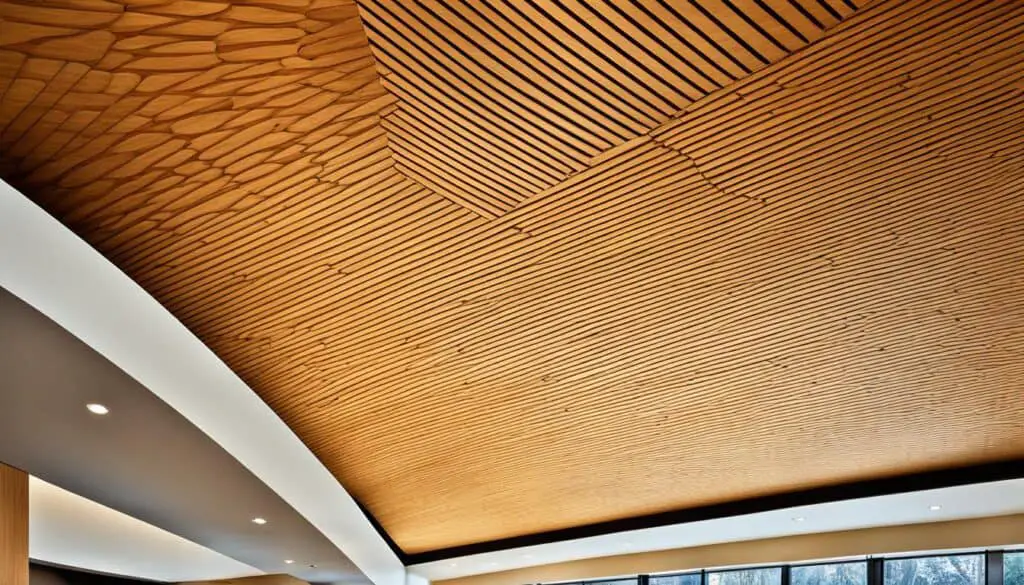
Simple Plywood Ceiling Design for Living Room
If you prefer a partial plywood ceiling design, consider adding designer panels to your living room. These panels line the walls and create a defined shape and structure for the room. The combination of plywood and plaster of Paris (PoP) in an asymmetric layered design adds visual interest and complements various decor styles.
To create a modern and sleek look, opt for designer plywood panels that are intricately crafted with unique patterns and textures. These panels can be customized to suit your preferences and can be installed in different orientations to create an eye-catching feature in your living room.
Advantages of Designer Plywood Panels
Designer plywood panels offer several advantages when used in a living room ceiling design:
- Enhanced Aesthetics: The unique patterns and textures of designer plywood panels can instantly elevate the visual appeal of your living room.
- Customizability: These panels can be tailored to your desired shape, size, and patterns, allowing you to create a personalized and individualistic design.
- Ease of Installation: Designer plywood panels are designed for easy installation, making it convenient to transform your living room without lengthy construction processes.
- Durability: Plywood is a durable material that can withstand the test of time, ensuring your living room ceiling remains beautiful and intact for years to come.
With designer plywood panels, you can add a touch of sophistication and elegance to your living room while enjoying the benefits of a durable and versatile ceiling solution.
Choosing the Right Designer Plywood Panels
When selecting designer plywood panels for your living room ceiling, consider the following factors:
| Factor | Considerations |
|---|---|
| Design and Pattern | Choose a design and pattern that complements your existing interior decor and enhances the overall aesthetic of your living room. |
| Quality of Plywood | Opt for high-quality plywood that is resistant to warping, moisture, and termites to ensure the longevity of your ceiling. |
| Installation Method | Check the recommended installation method for the designer plywood panels and ensure it aligns with your preferences and capabilities. |
| Budget | Determine your budget and explore different options within your price range to find the best designer plywood panels for your living room ceiling. |
By carefully considering these factors, you can find the perfect designer plywood panels that not only enhance the aesthetics of your living room but also meet your functional requirements.
Conclusion
In conclusion, plywood ceilings offer a wide range of design options and numerous benefits for stylish home interiors. Despite being slightly more expensive compared to other materials, plywood provides exceptional durability and versatility, making it a worthwhile investment. Although it is possible to undertake a DIY plywood ceiling installation, it is recommended to seek expert assistance to ensure precise cutting and handling.
One of the main advantages of plywood ceilings is the opportunity to integrate natural elements, such as wooden logs or exposed brick walls, providing a unique and personalized aesthetic to any space. Additionally, plywood ceilings offer excellent soundproofing benefits, creating a quieter and more enjoyable living environment.
Overall, plywood ceilings are a cost-effective and stylish option for transforming any room in your home. With their durability, versatility, and ability to combine with natural elements, they provide a long-lasting, visually appealing solution. Whether you opt for a slanting design, an all-white theme, or a suspended plywood structure, a plywood ceiling is sure to enhance the overall look and feel of your living space.
So, if you’re considering a ceiling renovation, don’t overlook the beauty and functionality of plywood ceilings. With their wide range of design options and the ability to create a unique, customized aesthetic, plywood ceilings are an excellent choice for homeowners looking to add style and sophistication to their interiors.
FAQ
What are some advantages of using plywood for a ceiling design?
Plywood ceilings offer durability, cost-effectiveness, soundproofing functionality, and the ability to conceal wires and pipes.
Are there any disadvantages to using plywood for a ceiling design?
While plywood ceilings are versatile and easy to handle, they can be more expensive than other materials like MDF, require expert cutting, and are prone to termite and water damage.
What is a slanting plywood ceiling design?
A slanting plywood ceiling design features plywood cut into various shapes and sizes to create a visually interesting and unique look.
What is a simple plywood ceiling design?
A simple plywood ceiling design integrates natural elements and works well when combined with wooden flooring and exposed brick walls to create a warm and inviting atmosphere.
How can an all-white plywood ceiling design enhance a bedroom?
An all-white plywood ceiling design can create a fresh and stylish look for a bedroom, especially when complemented with cottage-like plywood panels and statement decor elements.
What is a PoP and plywood combination design?
A PoP and plywood combination design involves the use of exposed plywood logs to create a natural and rustic feel, often paired with white-painted walls for a Moroccan-inspired look.
What is a wooden cabin-style plywood ceiling design?
A wooden cabin-style plywood ceiling design features a rectangular grid-style ceiling that adds a cozy and warm touch to a living room, giving it a cabin-like feel.
What is a latticework plywood ceiling design?
A latticework plywood ceiling design adds an ornamental and decorative look to a hall or large room, with intricate craftsmanship that creates a sense of old-world charm and elegance.
What is a suspended plywood ceiling design?
A suspended plywood ceiling design creates an open and spacious feel in a room and can be customized with additional decor elements like bohemian-style lamps or creepers.
How can wooden logs be incorporated into a plywood ceiling design?
Incorporating wooden logs into a plywood ceiling design creates a strong and robust look, often combined with plaster of Paris (PoP) and wood to enhance the overall aesthetic.
What is a cone-shaped plywood ceiling design?
A cone-shaped plywood ceiling design adds a unique and luxurious touch to a living room, with long curved panels and transparent glasses that allow for abundant natural sunlight.
What is a simple plywood ceiling design for a living room?
A simple plywood ceiling design for a living room involves adding designer panels to create a defined shape and structure, often combined with plywood and plaster of Paris (PoP) for visual interest.
How much does a plywood ceiling cost, and can I install it myself?
The cost of a plywood ceiling varies depending on the size of the space and the design complexity. While DIY installation is possible, it may require expert assistance for precise cutting and handling.

